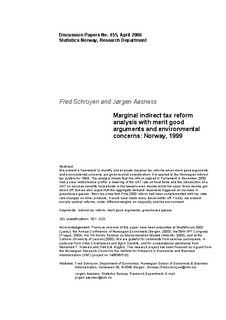| dc.contributor.author | Schroyen, Fred | |
| dc.contributor.author | Aasness, Jørgen | |
| dc.date.accessioned | 2011-11-20T19:36:50Z | |
| dc.date.available | 2011-11-20T19:36:50Z | |
| dc.date.issued | 2006 | |
| dc.identifier.issn | 1892-753x | |
| dc.identifier.uri | http://hdl.handle.net/11250/180713 | |
| dc.description.abstract | Abstract:
We present a framework to identify and evaluate marginal tax reforms when merit good arguments
and environmental concerns are given explicit consideration. It is applied to the Norwegian indirect
tax system for 1999. The analysis shows that the reform passed in Parliament in November 2000
had a clear redistributive profile: a lowering of the VAT rate on food items and the introduction of a
VAT on services benefits households in the lowest seven deciles while the upper three deciles got
worse off. But we also argue that the aggregate demand responses triggered an increase in
greenhouse gasses. Next, we show that if the 2000 reform had been complemented with tax rates
rate changes on other products, it could have made every decile better off. Finally, we present
socially optimal reforms, under different weights on inequality and the environment.
Keywords: indirect tax reform, merit good arguments, greenhouse gasses | no_NO |
| dc.language.iso | eng | no_NO |
| dc.publisher | Statistics Norway, Research Department | no_NO |
| dc.relation.ispartofseries | Discussion Papers;No. 455 | |
| dc.subject | Indirect tax reform | no_NO |
| dc.subject | Taxes | no_NO |
| dc.subject | Greenhouse gasses | no_NO |
| dc.subject | JEL classification: H21 | no_NO |
| dc.subject | JEL classification: H23 | no_NO |
| dc.title | Marginal indirect tax reform analysis with merit good arguments and environmental concerns: Norway, 1999 | no_NO |
| dc.type | Working paper | no_NO |
| dc.subject.nsi | VDP::Social science: 200::Economics: 210::Economics: 212 | no_NO |
| dc.source.pagenumber | 28 s. | no_NO |
